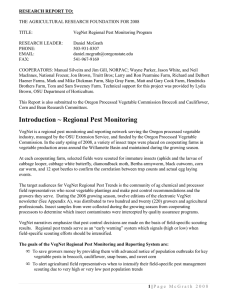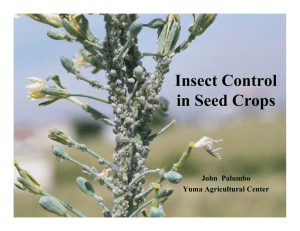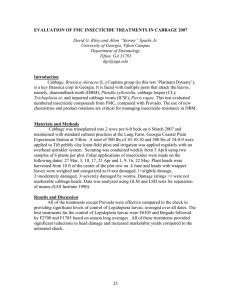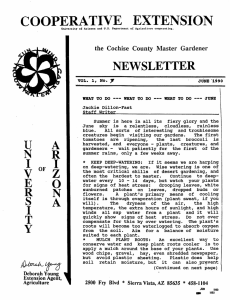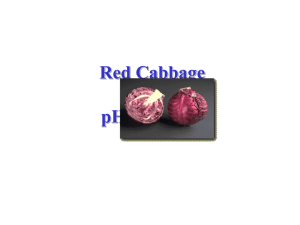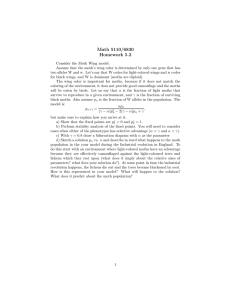THE AGRICULTURAL RESEARCH FOUNDATION FOR 2009 TITLE: VegNet Regional Pest Monitoring Program
advertisement
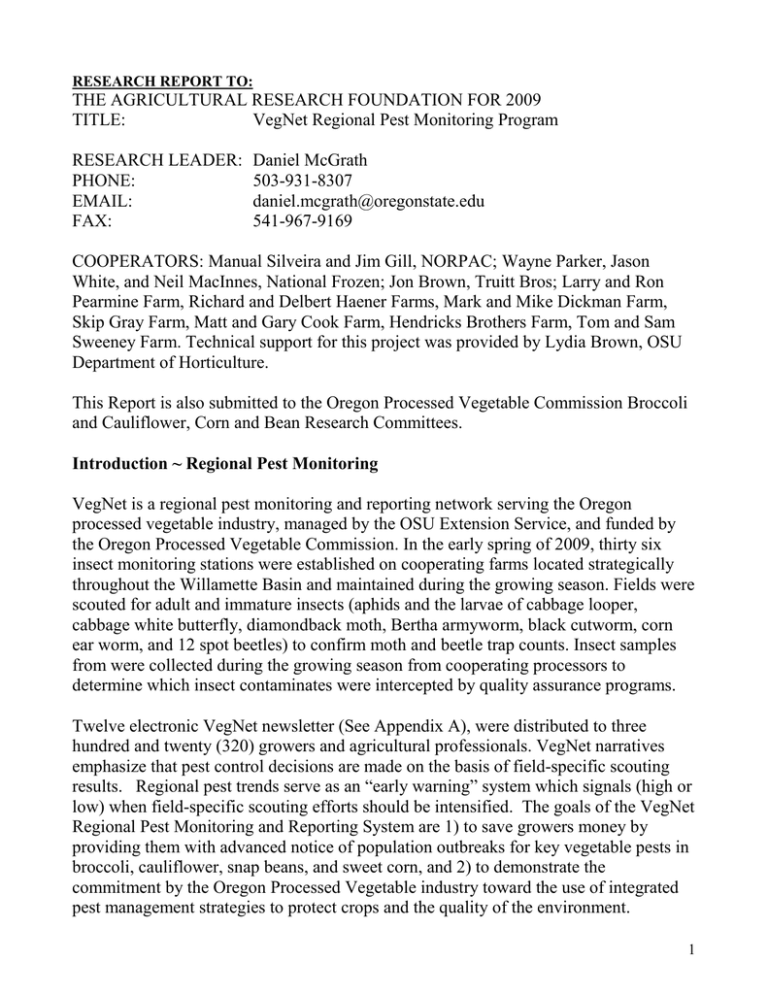
RESEARCH REPORT TO: THE AGRICULTURAL RESEARCH FOUNDATION FOR 2009 TITLE: VegNet Regional Pest Monitoring Program RESEARCH LEADER: PHONE: EMAIL: FAX: Daniel McGrath 503-931-8307 daniel.mcgrath@oregonstate.edu 541-967-9169 COOPERATORS: Manual Silveira and Jim Gill, NORPAC; Wayne Parker, Jason White, and Neil MacInnes, National Frozen; Jon Brown, Truitt Bros; Larry and Ron Pearmine Farm, Richard and Delbert Haener Farms, Mark and Mike Dickman Farm, Skip Gray Farm, Matt and Gary Cook Farm, Hendricks Brothers Farm, Tom and Sam Sweeney Farm. Technical support for this project was provided by Lydia Brown, OSU Department of Horticulture. This Report is also submitted to the Oregon Processed Vegetable Commission Broccoli and Cauliflower, Corn and Bean Research Committees. Introduction ~ Regional Pest Monitoring VegNet is a regional pest monitoring and reporting network serving the Oregon processed vegetable industry, managed by the OSU Extension Service, and funded by the Oregon Processed Vegetable Commission. In the early spring of 2009, thirty six insect monitoring stations were established on cooperating farms located strategically throughout the Willamette Basin and maintained during the growing season. Fields were scouted for adult and immature insects (aphids and the larvae of cabbage looper, cabbage white butterfly, diamondback moth, Bertha armyworm, black cutworm, corn ear worm, and 12 spot beetles) to confirm moth and beetle trap counts. Insect samples from were collected during the growing season from cooperating processors to determine which insect contaminates were intercepted by quality assurance programs. Twelve electronic VegNet newsletter (See Appendix A), were distributed to three hundred and twenty (320) growers and agricultural professionals. VegNet narratives emphasize that pest control decisions are made on the basis of field-specific scouting results. Regional pest trends serve as an “early warning” system which signals (high or low) when field-specific scouting efforts should be intensified. The goals of the VegNet Regional Pest Monitoring and Reporting System are 1) to save growers money by providing them with advanced notice of population outbreaks for key vegetable pests in broccoli, cauliflower, snap beans, and sweet corn, and 2) to demonstrate the commitment by the Oregon Processed Vegetable industry toward the use of integrated pest management strategies to protect crops and the quality of the environment. 1 Results Part One ~ Broccoli and Cauliflower Pests 15 -O ct p -S e 15 15 -O ct 15 -S ep 15 -A ug 15 -Ju l 15 -Ju n 15 -M ay 15 -A pr 15 -M ar Butterfly/2 Minutes/Site ug -A l 15 -J u 15 n -J u 15 ay -M 15 -A pr 15 15 -M ar Moths/Trap/Day Four Lepidopteron insects and one aphid species damage and contaminate broccoli and cauliflower: diamondback moth (Plutella xylostella), cabbage white butterfly (Pieris rapae), Bertha armyworm (Mamestra campestra), cabbage loopers (Trichoplusia ni), and the cabbage aphid Figure One: Cabbage Looper Moth Counts (Brevicorynae brassicae). Willamette Valley, Oregon 2009 Field scouting plus regional 45 pest monitoring generally do 2009 40 not lead to no-spray 10YrAve 35 decisions because the 30 probability of all five 25 contaminating insect 20 15 populations reaching low 10 levels during the same 5 growing season is very low. 0 Regional pest monitoring for broccoli and cauliflower pests is focused on detecting outbreaks and signaling growers and agricultural professionals Figure Two: Cabbage White Butterfly Counts when to intensify their field Willamette Valley 2009 8 scouting and to increase their aggressiveness in preventing crop 7 losses. Cabbage looper moth 2009 6 counts were above average during 7YrAve 5 the 2009 growing season (figure 4 one). Growers and agricultural 3 field representatives were notified via the VegNet email newsletter to 2 be cautious and to scout broccoli 1 and cauliflower fields carefully. 0 Early field scouting showed elevated numbers of eggs and small cabbage looper counts, confirming our concerns. Progress of looper population toward the papal stage was limited by naturally occurring viral disease. About one third (5/15) of the looper worms intercepted by processor quality assurance were visibly diseased. Cabbage white butterfly counts were below average during the 2009 growing season (figure two). 2 Diamondback moth counts (figure three) were above average, but their numbers did not qualify as an “outbreak”. Generally, it takes the combined outbreak of several insect populations during the same growing season to produce “worm” loads comparable to 1998. During the 1998 growing season, we had combined outbreaks of diamondback moth, cabbage looper, and cabbage white butterfly. In the field, there were so many cabbage whites flying I appeared like a snow storm. We collected over a thousand samples of insect contaminated broccoli (table one). During the 2009 growing season, the majority of contaminants were looper worms (figure four) but there were only thirty eight contaminated samples of broccoli during the entire growing season. No loads were rejected (table two). Following significant egg laying events, worm population can crash due to disease. During the 2009 growing season, we encountered a lot of diseased worms in the field. The relative proportion of cabbage looper, cabbage white butterfly larva, and diamondback moth worms in quality assurance samples varies from year to year. About one third (5/15) worms contaminating broccoli quality assurance samples were diseased. 3 Table One: Regional Looper Moth Counts Willamette Valley, Oregon 1998-2009 1998 1999 2000 2001 2002 2003 2004 2005 2006 2007 2008 2009 1st Flight 2nd Flight Looper High High #QA 1) 1) Pressure M/T/D M/T/D Samples moderate 4 31 1261 low 0.1 1 9 low 3 5 389 high 42 35 76 low 1 2 94 high 33 50 94 moderate 4 16 103 high 79 49 554 low na na na low 8 11 12 high 47 10 na high 24 42 38 1) Moths/trap/day averaged across all stations. %Loopers 68% 11% 21% 99% 20% 45% 73% 95% na 69% na 87% Table Two: Broccoli LosesDue to Looper Contamination Willamette Valley, Oregon 1998 to 2009 Year 1998 1999 2000 2001 2002 2003 2004 2005 2006 2007 2008 2009 Moth Counts moderate low low high low high moderate high low low High High Totes 1) Rejected 313 0 20 63 0 0 24 235 0 0 0 0 Loses Adjusted 2) by Volume ($/5,000Tons) $18,537 $0 $1,848 $8,043 $0 $0 $2,297 $17,938 $0 $0 $0 $0 1) Totes of broccoli rejected due to Cabbage looper contamination. 2) Dollar loses per ton of broccoli, average raw-product prices. 4 We detected a significant Bertha Armyworm outbreak in the Mt. Angel area (figure five, table three). This was reported to local growers. We think we “earned our keep” with this one. We may have saved thirty acres of drip irrigated bell peppers grown for processing. We have not had a regional Bertha Armyworm outbreak for over ten years. Table Three - Localized Bertha Armyworm Outbreak 2009 Aurora Dayton MtAngel Salem Stayton Dever Corvallis WV Ave 6-Apr na na 0.00 na 0.00 0.00 0.00 0.00 13-Apr 0.00 na 0.00 na 0.00 0.00 0.00 0.00 20-Apr 0.00 na 0.00 na 0.00 0.00 0.00 0.00 27-Apr 0.00 na na 0.00 na 0.00 na 0.00 4-May 0.00 na 0.00 0.00 na 0.00 0.00 0.00 11-May 0.00 na 0.00 0.00 0.00 0.00 0.00 0.00 18-May 0.00 na 0.00 0.00 0.00 0.00 0.00 25-May 0.00 na 0.00 2.22 0.00 0.00 0.00 0.00 0.37 1-Jun 0.00 na 1.00 0.00 0.00 0.00 0.00 0.17 8-Jun na na 0.18 0.00 na 0.00 0.00 0.05 15-Jun 0.00 na 0.50 0.00 0.00 0.00 0.00 0.08 22-Jun 0.00 na 0.00 0.00 0.17 0.00 na 0.03 29-Jun na na 0.00 0.00 na 0.00 0.00 0.00 6-Jul 0.00 na 0.00 0.00 0.00 0.00 0.00 0.00 13-Jul 0.00 na 0.00 0.00 0.00 0.00 0.00 0.00 20-Jul 0.00 na 0.00 0.00 0.00 0.00 0.00 27-Jul 0.00 na 0.00 0.80 0.00 0.00 na 0.00 0.16 3-Aug 0.00 na 0.80 0.29 0.00 0.00 0.00 0.18 10-Aug 0.00 na 2.70 0.25 0.10 0.00 0.00 0.51 17-Aug 0.00 na 2.33 0.11 0.17 0.00 0.00 0.44 24-Aug 0.00 na 1.38 0.00 0.13 0.00 na 0.30 31-Aug 0.00 na 0.57 0.71 0.00 0.00 0.00 0.21 7-Sep 0.00 na 1.50 0.00 0.25 0.00 0.00 0.29 14-Sep 0.00 na 0.00 0.00 0.00 0.00 0.00 0.00 21-Sep 0.00 na 0.00 0.00 na 0.00 0.00 0.00 28-Sep 0.00 na 0.00 0.00 na 0.00 0.00 0.00 5 Results Part One ~ Snap Bean Pests Twelve spot beetle populations were above average during the 2009 growing season. Growers were able to take advantage of a sustained period of low beetle pressure during the early flower period to reduce insecticide sprays based on sweep net sampling and action thresholds. No loads of beans were rejected due to bug bite in 2009. Results Part One ~ Sweet Corn Pests Black cutworm outbreaks occur about once per decade. Cutworms are hard to detect in the field because early cutworm instars are small, gray-brown in color, and subterranean. Significant cutworm moth egg laying flights, on the other hand, are easy detect. The last major Willamette Valley black cutworm outbreak occurred in 1997. Based on historical trends, we are due for another black cutworm outbreak in the near future. Black cutworm moth counts were below average during the 2009 growing season. Corn earworm moth counts were average on a regional basis during 2009 but variable from field to field (figure seven). Even in a low pressure year, fresh market growers will need to apply insecticide sprays at first silk. Corn earworm pressure was significantly lower than during the 2007 and 2008 growing seasons. 6 The VegNet regional pest monitoring program sponsored by the Oregon Processed Vegetable Commission has been fruitful. The program has, on occasion, saved growers money by providing growers and agricultural professionals with early warnings of insect pest outbreaks. The combination of regional pest monitoring plus field scouting has allowed growers, in some cases, to reduce insecticide applications without significantly increasing risk of crop damage. Processors have taken advantage of this integrated pest management program in their stewardship marketing campaigns. This may have helped Oregon processors maintain market shares with national brokers of processed food who are aggressively looking for ways to protect and enhance their brand image. We learn something new every year. Last year, Bertha armyworm caught us off guard. At least one grower lost a lot of money due to a Bertha armyworm infestation in peppers. During the 2009 growing season, Bertha moth counts were fairly low on a regional basis except in one region of the valley, Mt. Angel. We recognized the pattern and were able to provide the growers in the Mt. Angel area with advanced notice of the outbreak. To our knowledge, no crop losses due to Bertha armyworm occurred in 2009. Occasionally, we earn our keep. The VegNet Newsletter, which is widely circulated in the Willamette Basin serves as a platform for dealing with new issues that arise during the growing season. For example, this year prior to pea harvest, we had what appeared to be a pea aphid outbreak. We needed an action threshold. We tracked down a research paper that specifically addressed peas, pea aphids, and action thresholds. We distilled this information and got the data out to growers and agricultural professionals very rapidly. (Appendix A). 7 VegNet VegNet is a pest and disease monitoring and reporting network serving the processed vegetable industry, provided by the Oregon State University Extension Service, and funded by the Oregon Processed Vegetable Commission. VegNet is available on the net: http://extension.oregonstate.edu/linn Go to commercial vegetables then VegNet. If you have questions or suggestions, and if you would like to add or remove your name from this newsletter mailing list, Contact: Dan McGrath, OSU Extension, PO Box 765, Albany, OR 97321 phone (503) 931-8307; email daniel.mcgrath@oregonstate.edu June 19, 2009 Corn Earworm We are starting to see a few moths in our traps. Counts are a little above average, but not too much. We will continue to watch this population. Pea Aphid Cabbage Looper Counts are above average and higher than last year. They are higher in the north end of the valley. I would recommend paying attention to your button and pre harvest sprays in broccoli. We are into the second looper flight of the summer. Having said this, it usually takes a true outbreak in several insects (cabbage looper, cabbage white butterfly, and diamondback moth) to cause big problems. Still, be careful. Check your fields. Bertha Armyworm We continue to catch a few moths in the Mount Angel area. We will keep you posted. We expect the second generation flight to begin in early July. We do not have a sweep net based action threshold, to my knowledge, in peas. If you sweep net aphids in peas and detect aphids, then I would recommend that you also sample ten plants. Based on research out of WSU, if you find on average two to four (2-4) aphids per pea plant, insecticide application may be justified. Other Insects We had an intense year for stripped cucumber beetles in squash and cucumbers. The cabbage white butterfly counts are still relatively low. Flea beetles have been a challenge, especially in the south end of the valley. Scout emerging or recently transplanted broccoli and cauliflower for flea beetles. Be careful. 8 VEGNET 2009 BCW CEW PHX 12S-YST 12S-SN CL AL DBM BAW VCW CWB/2min Week of June 15, 2009 Willamette Valley, Oregon Aurora Dayton MtAngel Gervais Stayton Dever Corvallis 0.31 na 0.00 0.00 0.00 0.50 0.00 0.15 na 1.75 0.50 0.00 0.00 0.00 0.00 na 0.25 0.00 0.00 0.00 0.11 0.08 na 0.25 0.50 0.00 0.00 0.11 na na na na na na na 11.15 na 45.50 40.75 17.25 2.10 2.00 0.00 na 0.50 0.00 0.00 0.00 0.00 9.00 na 11.00 5.00 0.75 0.00 0.56 0.00 na 0.50 0.00 0.00 0.00 0.00 1.77 na 5.00 1.00 0.25 1.30 0.00 1.00 na 0.00 1.00 0.00 1.00 0.00 Willamette Valley 7day Ave Week of June 15 5-Yr Insects Ave. 2008 2009 Note BCW 0.90 0.00 0.13 Normal risk CEW 0.14 0.00 0.40 Above Average PHX 0.03 0.00 0.06 Normal risk 12S-YST 0.13 0.00 0.16 Normal risk 12S-SN na na na Normal risk CL 4.00 12.56 19.79 Above Average AL 0.22 0.00 0.08 Normal risk DBM 8.80 0.66 4.38 Normal risk BAW na 0.08 0.08 Normal risk VCW 5.87 4.42 1.55 Normal risk 0.7 0.00 0.50 Normal risk CWB/2min VegNet Key BCW = Black Cutworm Moths PHX = False Corn Earworm Moths CL = Cabbage Looper Moths DBM = Diamondback Moths VCW = Varigated Cutworm Moths YST = Yellow Sticky Trap Counts na = not available CEW = Corn Earworm Moths 12S = 12 Spot Beetle AL = Alfalfa Looper Moths BAW = Bertha Armyworm Moths CWB/2min = Cabbage Butterflies SN = Sweep Net Counts/10 Arcs 9
